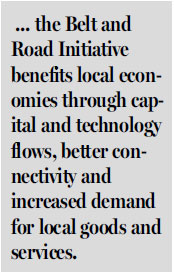Belt and Road positive force for Middle East
The Silk Road Economic Belt and the 21st Century Maritime Silk Road, commonly known as the Belt and Road Initiative, is a grand vision for China's engagement with roughly 70 countries that are home to two-thirds of the world's population. The Belt and Road Initiative, launched in 2013, has taken on a central role in China's foreign and trade policies and has had a positive impact on developing countries, including those in the Middle East.
However, the initiative has attracted some criticism globally. It has been described as a program to promote China's strategic objectives at the expense of other countries, or a "debt trap" leading to Chinese ownership of key foreign assets, financed by Chinese funds and built by Chinese companies using their labor, equipment and technology. These claims are questionable.

First, China does seek to promote its interests by accessing major trade routes and commercial hubs, and by selling its goods globally. That is what a large economy does - it works to expand its spheres of influence and economic interests. In fact, every country acts according to what it believes to be in its self-interest.















